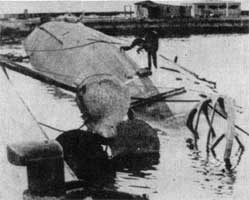|
ORP Wicher was launched on 19.II.1927, in Chantiers Naval Francais in Caen, under command of cmdr. Tadeusz Podjazd - Morgenstern. On 15.VII.1930 ship sailed to Gdynia. When Wicher entered the harbour she was cheered by huge crowd of Polish citizens. From 8 to 13.VIII.1930 Wicher together with torpedo boat Mazur, was escorting liner Polonia with president Moscicki onboard, on his visit to Estonia. Next year in March Wicher visited Lisbon, from which she sailed to Madera, where Marshall Pilsudski, was embarked. On 28.III.1931 Wicher reached Gdynia. Until the December 1931 ship was on drills. On 14.VI.1932 Wicher sailed to the Gdansk harbour and day later welcomed the British group of ships. In August 1932, the group of Polish ships (both Polish destroyers and three minelyaing submarines) visited Stockholm, with adm. Unrug on Wicher's board. In July 1934, together with Burza, Wicher visited Soviet Leningrad. In 1935 Wicher and Burza visited Cologne (26-29.VI), Helsinki (7-10.VII) and Tallinn (17-20.VII). In October Wicher was modernised: the stern mast was removed, two MG were added. In June 1937 Wicher made a long voyage, sailing round the Baltic with the petty-officers. Month later, big "W" letter was removed from the hull and in September Wicher went to the yard, for short repairs. In March 1938 last commander of the ship was appointed cmdr. Stefan de Walden.
On the first day of the war, in early hours of the day Wicher, spotted enemy planes and opened fire to them. On 16:00 operation "Rurka" (Tube) started. Wicher with 2 gunboats and 6 minesweepers were escorting minelayer Gryf on it's way from Gdynia to Hel. Hour later on the waters of the Danzig Bay, Polish ships were attacked by 33 Ju 87.
 | | Sunken Wicher in the Hela harbour |
During 180 minutes of battle none of the enemy bombers was shot down, but also none of the ships was hit, though Mewa and Gryf were damaged by the bombs. Later that night, Wicher went out on the patrol, according to the "Rurka" plan. But cmdr. de Walden, didn't know that because of the Gryf's damages, the operation was cancelled!! On 22:00 near Pillau Wicher spotted 2 German destroyers on their way to the West. Both enemy vessels were perfectly visible on the background of the moon, and Polish destroyers wasn't visible at all on the grey background of the coast. No action took place because of the orders, from operation "Rurka". Wicher couldn't open fire, because it's aim was to protect minelayers, and the mine pole shouldn't be dislocated. Around 1:00 Wicher arrived to the Hel harbour, and was immobilised. On 7:00, lonely Do 17 attacked destroyer and was shut down by Wicher's artillery. All day ship was defending the harbour from the enemy bombers, but none of the German planes was destroyed. Next day, 3.IX in the early hours, two German destroyers: Leberecht Maas and Wolfgang Zenker, appeared near Hela Peninsula,of which Maas was damaged by Polish artillery. At 9am Wicher and Gryf were sunk by enemy diving bombers from 4th Tragergruppe.
Wicher was hit by 4 bombs and sunk near the pier. One sailor was dead, 22 were wounded. After Polish surrender, in November 1939 Germans, refitted the ship, and towed it on the shallow. After the war in 1946 the wreck was towed and sunk in position: 54'36N/18'47E. Later it was used as a air target, until 1963 when it was raised and finally scrapped.
|